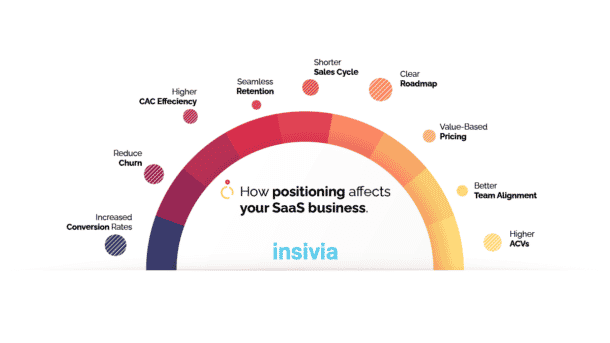If your SaaS product tries to target everyone you end up not reaching anyone. Let’s talk about market positioning.
It’s a concept that is not too difficult to understand but is all too often ignored by companies in both their overall strategy and marketing efforts. The difficulty arises because we don’t want to turn down or miss an opportunity – that’s natural.
For early stage SaaS companies as well as more mature enterprise software or tech consulting firms, this can be a struggle.
If you look at most major companies, they started off with a position and narrow segment, then as they gained market share and traction they expanded. Facebook only allowed certain college students to join at first and Amazon just wanted to make buying unique books easier. They both may have had a bigger vision, but they started their journey off with a wall to defend their position from.
We believe that brand strategy and positioning has the opportunity to be the biggest catalyst for growth in a company’s journey. The ability to target and effectively execute into that segment creates the momentum for fast revenue growth.
We start with narrowing down our audience through targeting.
We get it. When facing a drive or the demand to grow, the instinct is to go after everyone.
Sitting down and crossing groups of customers off our list to focus on can be a challenging and painful process but we must do it. The key here is to do it logically and intelligently with as minimal bias as possible.
There are several factors that we use to support our audience narrowing process. This can be done anecdotally, but if you want the absolute best result it should be done with expansive research to fill in gaps and confirm our assumptions.
First, if you are doing the process right, you have broken down audiences into minute groups. Like revealing the layers of an onion until you get down to very specific audiences to consider.
Here are factors that we consider:
- Size of target audience. yes, we are narrowing down, but we also do not want an audience that is extremely hard to gain realistic market share and be profitable.
- Specialization. One of our favorites, is how unique your product or service is customized to that audience. Think about if your SaaS product is HIPPA compliant, it has high specialization for healthcare.
- Experience. How long have you done work or provided offerings to this audience already?
- Competition. Are there a lot of competitors and alternatives? And how much market share do they already own?
- Demand. How much does this audience want what you have? Is it an absolute need ( like regulatory compliance ) or just a nice to have. Will they pay premium prices for it?
- Interest. This one is more personal, but we like including it. How much does this audience get your blood going to work with?
When evaluated on a linear scale without bias and with the backing of research, this becomes a strong litmus to narrow your audience. In some ways, if it doesn’t feel uncomfortable, you didn’t narrow down your evaluation groups enough.
Niche market combined with product focus creates intense demand.
Identifying a narrow target audience and niching down benefits SaaS brands:
- Understand your audience more in depth.
- Simplify contact acquisition.
- Narrow content for improved SEO.
- Higher conversion rates through personalized content.
- Faster confidence building and validation.
Product Focus is about how specialized your SaaS product is to the target audience.
- Unique features for the target audience.
- Required compliance for the audience.
- Paired services for the audience.
- Specialized market integrations.
As we look at increasing the demand for our product, we can leverage market focus and product-fit.
- Broad Market + Broad Product Positioning
Weak Demand as your try to capture too many audiences and deliver value to too many audiences. - Broad Market + High Product Focus Positioning
In many cases, a high product focus narrows your audience, but also can solve a very narrow issue for a lot of people. - Narrow Market + High Product Focus Positioning
When you target a very specific audience and specialize your product to them and their needs, you create the strongest demand. - Multiple Narrow Market + High Product Focus Positioning
Often when SaaS companies that have focused winning solid market share in a niche, the strategy for growth is to expand into new niches with new products or versions of products for those new audiences.
Then Leverage SaaS Brand Positioning To Establish A Unique Message
Now that we have narrowed down our target audience, we must create a compelling marketing message to engage, convey, excite and convert our audiences.
We call it positioning because we are looking to place you uniquely in the market compared to others – a weak position can often put you too close to your competitors or even standing behind them in their shadow.
Our goal is to create a position that breaks you away from others so that the audience sees you as the only choice. One methodology our firm uses in its SaaS Market Position consulting is blue ocean strategy which describes a red ocean as being so competitive there is blood in the water – but that finding a blue ocean means that you separate yourself from competition.

This ability to position yourself correctly can influence marketing significantly as well as sales, customer service, product development and your overall word-of-mouth from existing customers. So, getting it right is extremely important.
There are many strategies and exercises that can help develop a unique position, but there is a reason that companies bring in a consultant — an unbiased opinion. Positioning is easy to get wrong when you are overloaded with past history, market knowledge and competitor awareness. Your prospects don’t have the same baggage you carry, so trying to create a position from a position of bias is a huge mistake.
Our approach for positioning mixes various methodologies, but it all comes down to a few key factors:
- What is it that your audience is using to make a decision.
- Which of those are you great at.
- What are your competitors strong at.
- Where is the gap.
- How can you backup your claim?
- How can you articulate it in a way that ensures differentiation?
The right position will come primarily from these questions given that you unbiasedly have understand your audience, competitors and company.
Use SaaS Marketing Segmentation To Ensure The Right Message To The Right Audience
For SaaS companies, market segmentation is important to speak personally to different audiences. This could be a seperation of industries you target with your product and/or the various roles that are involved in research, usage and decision making for your product.
Segmentation should be a derivative of your core positioning that is specialized and adapted for the specific audience.
Segmentation when done correctly will impact your approach to marketing in making sure that the right channels are used and the right message for groups you target. It then expands into your web and conversion strategy to personalize your site to the audience and increase the rates of action.
What is important to understand is that people will resonate with messaging that specifically speaks to their needs, wants and pains. If I land on a page that generically talks about a software product, I have to do the heavy lifting to connect the dots to my needs. The alternative is to land on a page that talks specifically to me – you do the heavy lifting for them and reduce the friction for conversion.
If segmentation is not a part of your strategy, it is most likely that you are significantly less effective than you could be and not achieving your best marketing ROI.
Tying together your SaaS Targeting, Positioning & Segmentation
You can see that this is a progressive exercise that gets you to a point of highly effective marketing, sales and customer experience.
Yes, your targeting can be wide, your positioning similar to others in the market and your tactics generic — but all of those contribute to extremely low conversion and make you significantly less effective.
As a leader, being as efficient and effective in revenue generation as possible should be at the top of your strategy. By putting the effort into targeting, positioning and segmentation you are influencing every aspect of the business for years.
Don’t be biased and don’t take it lightly. Do it right and be highly effective.
